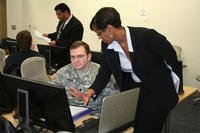Medical Transcription: An Ideal Career for Military Spouses
Medical Transcription: An Ideal Career for Military Spouses>>Download PDF version here. >>Download Mission: Medical Transcription Brochure >>Request more information on medical transcription opportunities for military spouses. TABLE OF CONTENTS What is a Medical Transcriptionist?
How Do I Train for Medical Transcription?
Who Promotes Medical Transcription?
What is the Future of Medical Transcription?
What do Military Spouses Say about this Career?
What does a medical transcriptionist do? In the broadest sense, medical transcription is the act of translating from oral to written form (on paper or electronically) the record of a person's encounter with a healthcare professional. Medical transcriptionists (MTs) are specialists in medical language and healthcare documentation. They interpret and transcribe dictation by physicians and other healthcare professionals regarding patient assessment, workup, therapeutic procedures, clinical course, diagnosis, prognosis, etc., editing dictated material for grammar and clarity as necessary and appropriate. Physicians and other healthcare providers employ state-of-the-art electronic technology to dictate and transmit highly technical and confidential information about their patients. These medical professionals rely on skilled medical transcriptionists to transform spoken words into comprehensive records that accurately communicate medical information. Speech recognition systems also may be used as an intermediary to translate the medical professional's dictation into rough draft. The medical transcriptionist is on the frontline to implement risk management by further refining the draft into a finished document. This requires listening to dictation while reading the draft created via speech recognition technology and editing the text on a computer screen. This editing may range from minimal to extensive, depending on the capabilities of the speech recognition software and the dictating habits of the originator, and may include correction of content as well as punctuation, grammar, and style. The electronic health record (EHR) facilitates storage of an individual's health history so that it may be accessed by physicians and other healthcare providers anywhere. The military implements the electronic health record. Primary care managers (PCMs) are able to view onscreen previous visit history and order meds and diagnostic studies in the patient’s presence. In this setting, the MT and EHR play a blended role. Generally speaking, medical transcription can be performed by anyone with access to a high-speed internet connection regardless of geographic boundaries. What personal characteristics do I need in order to become a medical transcriptionist? You need excellent English grammar skills, as well as a compelling interest in and knowledge of continuous new medical equipment and procedures, scientific updates, federally approved pharmaceutical products, etc., which are reflected in medical language. You need superior resource skills. You need hand-eye coordination and keen listening skills. You need reasonable computer keyboarding skills and sit for long hours, often in a high-pressure environment. Medical documents often are requested to be expedited copy. A high level of concentration for extended periods of time is also important. Medical transcription requires a practical knowledge of medical language relating to anatomy, physiology, disease processes, pharmacology, laboratory medicine, and the internal organization of medical reports. A transcriptionist is a medical language specialist who must be aware of standards and requirements that apply to the health record, as well as the legal significance of medical transcripts. Where do medical transcriptionists work? Medical transcriptionists use their talents in a variety of healthcare settings, including doctors' offices, public and private hospitals, teaching hospitals, medical schools, medical transcription businesses, clinics, laboratories, pathology and radiology departments, insurance companies, medical libraries, government medical facilities, rehabilitation centers, legal offices, research centers, veterinary medical facilities, and associations representing the healthcare industry—wherever dictation for the purpose of healthcare documentation requires transcription. Many MTs work from their homes as independent contractors, subcontractors, or home-based employees. Who do medical transcriptionists work for? Medical transcriptionists work with physicians and surgeons in multiple specialties. They work with pharmacists, therapists, technicians, nurses, dietitians, social workers, psychologists, and other medical personnel. All of these healthcare providers rely on information that is received, accurately documented, and disseminated by the medical transcriptionist. Where can I learn more about medical transcription? Go to the AAMT website, http://www.aamt.org. Click on the Visitor Center > About Medical Transcription. Follow the related links of information.
What is the initial point of contact to begin MT education?http://www.aamt.org The American Association for Medical Transcription (AAMT) is the recognized leader in establishing medical transcription styles, forms, and practices. It is the organization that represents MTs globally to direct the evolution of the medical transcription profession, to advance and represent the profession of medical transcription through the promotion of quality healthcare documentation. Its purpose is to set and uphold standards for education and practice in the field of medical transcription that ensure the highest level of accuracy, privacy, and security of healthcare documentation for the U.S. healthcare system in order to protect public health, increase patient safety, and improve quality of care for healthcare consumers. AAMT provides medical transcriptionists with tools to improve patient safety and quality of care. Which schools are approved? http://www.aamt.org/scriptcontent/mtapproved.cfm There are many training programs that make big promises about their ability to prepare you for job readiness so that you can work from home and make a lot of money. The reality is that very few of those programs have done their homework about the kind of curriculum it takes to ensure the level of job readiness that the industry demands from a graduate. Despite the fact that AAMT has provided standards for MT education, there are still many MT programs online and at the community college level that are operating below those standards. Go to the online AAMT Home Page > Visitor Center > Choosing an MT School. This outlines the criteria AAMT considers essential to an effective educational program. You can use this information as a checklist to evaluate any of the ACCP-approved schools you may consider. As you will note in “Choosing an MT School,” it is recommended that prospective students look for schools whose advertising emphasizes excellence in medical transcription, rather than focusing on the ideas of working at home or completing a program rapidly. It is also recommended that prospective students look for programs that focus solely on medical transcription, rather than offering courses for a number of different professions. For that reason, AAMT recently established an education program approval process to evaluate programs that teach medical transcription. These programs satisfy all the requirements AAMT has established and have demonstrated a meritorious record of job placement for their graduates. These programs are highly regarded by MT employers who seek out these graduates because of their job readiness. Detailed information about approved schools is found on the AAMT website http://www.aamt.org/scriptcontent/mtapproved.cfm A joint committee, the Approval Committee for Certificate Programs, (ACCP) was established by AAMT and AHIMA for certifying and approving medical transcription education programs. The ACCP education approval committee approved the first school in 2005. The ACCP education approval program is ongoing. Visit the website frequently to note newly approved schools. Employers in today's production-focused environment do not have the resources to hand-hold substandard graduates through a long acclimation period of on-the-job training. It is costly and time-consuming, and many employers no longer take a risk on graduates from programs that do not have a good track record of graduating job-ready MTs. Employers are now turning to the ACCP education approval process to set the standard for entry to practice. Graduates from the approved programs continue to be highly sought after by industry employers for that reason. What should I ask when I contact a school? Use the “Choosing an MT School” tip sheet as a checklist. Add your own questions and use the sheet to answer every question for every school you consider. Ask about the amount of authentic physician dictation which is used for practice and then make appropriate use of every opportunity to practice. If the dictation is not there, the best student is unlikely to succeed. “Authentic dictation” is actually dictated by real clinicians under real circumstances; regardless how hard anyone tries to duplicate authenticity, there is something about reading that gives it a rhythm and flow that you will not encounter in real life. Ask whether there are real transcriptionists (preferably CMTs) teaching the transcription practice portion of the program or mentoring students through transcription practice. Real MTs bring on-the-job experience to your academic studies and to transcription practice. Interview the instructors and directors of the programs, the people with whom you will be interacting. Talk with them by phone and see with whom you have the best rapport. All things being equal (including the authentic dictation advice above), choose the school with whom you feel you can establish the best relationship. It's difficult to learn medical transcription under the best of conditions; it won't help at all if you find yourself in a situation where you just don't "click" with an instructor. Is distance-learning a good idea? Ask yourself questions: Am I able to work independently? If I work elsewhere and/or have children, am I able to find the necessary time and privacy for uninterrupted study? Am I self-directed? Are my computer skills such that I need only minimal support? Can I establish a schedule and stick to it? Am I a critical thinker to reason through some problems on my own? (You may not always have access to immediate feedback, even in the best of schools.) Why are some schools more expensive than others? Only a detailed comparison of education program benefits and resources can help you reasonably determine why one school may charge more than another. Again, use the “Choosing an MT School” document from the AAMT website. Go item-by-item down the list and evaluate the school you've chosen. If you have more than one possible school in mind, you may want to make a spreadsheet or table and compare the responses you get from the 2 schools in question. How long does it take to become a medical transcriptionist? Generally speaking, MT courses take 12-18 months to complete. This varies with each approved school and can be best determined by reviewing the websites and curricula and interviewing the administration of each school you consider. Another subjective factor depends on how quickly you grasp the information and how many hours per day you spend pursuing your goal. What is an apprenticeable occupation? An apprenticeable occupation is a skilled trade which possesses all of the following characteristics. It is customarily learned in a practical way through a structured, systematic program of on-the-job supervised training. It is clearly identified and commonly recognized throughout an industry. It involves manual, mechanical and technical skills and knowledge which require a minimum of 2,000 hours of on-the job work experience. It requires related instruction to supplement the on-the-job training. Specifically, the MT Registered Apprenticeship candidate is a graduate from an ACCP-approved school recognized by MTIA who has earned the RMT credential from AAMT. This makes the MT eligible to apply to MTIA for the Registered Apprenticeship Program and be placed with an employer as a 2-year apprentice in the area of acute care. What role does government play in MT apprenticeship? The National Apprenticeship Act of 1937 authorizes the federal government, in cooperation with the states, to oversee the nation's apprenticeship system. The U.S. Department of Labor's Bureau of Apprenticeship and Training, in conjunction with state apprenticeship agencies, is responsible for registering apprenticeship programs that meet federal and state standards, issuing Certificates of Completion to apprentices, encouraging the development of new programs through marketing and technical assistance, protecting the safety of and welfare of apprentices, and assuring that all programs provide high quality training to their apprentices. The Registered Apprenticeship Program, sponsored by the Medical Transcription Industry Association (MTIA), offers structured, on-the-job learning, and related technical instruction for qualified medical transcriptionists entering the profession. Why does the Department of Defense consider this careerappropriate for apprenticeship for military spouses? According to Department of Defense research, there are 700,000 military spouses. As of March 2006, graduates of selected medical transcription training programs will now have access to registered apprenticeship programs, as the U.S. Department of Labor has now declared medical transcription to be an apprenticeable profession – the first step in establishing a national apprenticeship program. The Office of Apprenticeship Training, Employer and Labor Services approved the application for apprenticeability determination submitted by the Medical Transcription Industry Association (MTIA). Under standards established by this apprenticeship program, the graduate MT will be facilitated to transition from student to an employable, productive, and viable career for which there is currently a shortage of professionals. Based on the availability of approved training programs and hiring practices along with the projected future growth of the industry, the Department of Defense and Department of Labor together with AAMT, support medical transcription courses for assisting military spouse employability. How does Registered Apprenticeship work?Apprenticeship programs are operated by both the public and private sectors. Apprenticeship sponsors, who are employers, employer associations, and labor-management organizations, register their programs with federal and state government agencies. Sponsors provide on-the-job learning and academic instruction to apprentices according to their industry standards and licensing requirements. Through the Apprenticeship Agreement, an apprentice as an employee receives supervised, structured on-the-job training combined with related technical instruction. Related instruction is a required component of an apprenticeship program which supplements the on-the-job training. A minimum of 144 hours per year is required for each occupation. The related instruction may be given in a classroom through trade, industrial or correspondence courses of equivalent value, or other forms of self study approved by the registration/approval agency. Upon completing an apprenticeship of 1-5 years (2,000 hours to 10,000 hours), the worker receives an Apprenticeship Completion Certificate and is recognized as a qualified worker nationwide. This certificate is one of the oldest, most basic, and most highly portable industry credentials in use today. The certificate is issued by a federally approved State Apprenticeship Council or Agency or, in those states not having such an agency, by the Bureau of Apprenticeship and Training. Are apprentices paid?Yes, apprentices in Registered Apprenticeship programs earn while they learn, because they are full-time employees during their apprenticeship. A progressively increasing schedule of wages is based on the experienced worker's hourly wage of the apprentice's occupation. These wages increase upon demonstration of satisfactory progress in both related instruction and on-the-job training until wages reach 85% to 90% of the rate paid the experienced worker in the occupation. Generally, apprentices start at 50% of the wage an employer pays an experienced worker in that occupation (but the apprentice cannot receive less than the state minimum wage). The apprentices' wages are increased periodically throughout the apprenticeship to reflect their mastery of the occupational skills and their ability to work independently. In developing and implementing a wage schedule, the sponsor agrees to grant periodic wage increments when the apprentice is performing satisfactorily. A successful Registered Apprenticeship program can
Benefits to the employer
Benefits to the apprentice
In the United States today, some 40,000 program sponsors offer Registered Apprenticeship training to approximately 325,000 apprentices. These training programs serve a diverse population including minorities, women, youth and dislocated workers as well as disabled workers who qualify otherwise. Currently, at least two-thirds of all apprenticeship training positions are in the construction and manufacturing industries. Experts agree that apprenticeship has the potential to benefit numerous other industries as well (e.g., service, retail, healthcare, public sector). Thus, the possibilities for expanding the apprenticeship model are virtually unlimited, thereby meeting the needs of many more American companies and citizens in search of high quality training opportunities - are virtually unlimited. What is the point of contact for federally approved MT Registered Apprenticeship Program? http://www.mtia.com P.J. Posey, CMT, Chair, MTIA Workforce Development Committee How do I find employment once I complete school? Medical transcription should not be viewed as a part-time job for those entering the profession for the first time. Those who commit themselves to working full time in order to build up their level of productivity are considered to be a good investment for the employer. It may be possible for an individual to scale back to part-time work after having mastered the medical language and become proficient in medical transcription technology, but it is unwise to look upon medical transcription as a part-time opportunity when first entering the profession. Two best sources for a job lie within yourself coupled with your school. Graduates from approved schools who demonstrate 98% accuracy in transcription are the most sought after by employers. Push yourself to excel, and work with the contacts your school has to place you. Employers are aware of the reputations the schools have and often have standing requests for their graduates, and best students often have choices where to work. In additional to traditional employability which abounds, the MT skill set is applicable to support alternative health practitioners, insurance companies, scientific research facilities, medical malpractice attorneys, medical society offices, private detectives, academia with science or medicine departments, biotechnology companies (research and manufacturing), forensic psychiatry, pharmaceutical industry (research, development, sales, support), medical software development, veterinary offices, managed care organizations, medical and allied health publishing entities, and many more. Can I work at home? While many medical transcriptionists do work from their homes, the opportunity to work from home is not sufficient reason to enter this challenging profession. Medical transcriptionists must be intensely focused on medical language and the importance of documenting highly sensitive patient healthcare documents and must be dedicated to quality, privacy, and accuracy in all of their efforts. Medical transcription is not “just a typing job,” but rather a professional field where only the most dedicated practitioners will be successful. More and more employers are allowing their experienced MTs to work from home. However, many will require you to work at their facility or in their office before sending you home to work on your own. The home transcriptionist needs an excellent knowledge of the medical language, as well as the English language, and may have to make a substantial investment in reference materials and equipment. Those who provide the highest quality transcription are most likely to be successful. However, there are medical transcription service owners (MTSOs) who hire MTs and train them, providing mentors and entry-level transcription initially. Can I be self-employed or own my own MT business? The independent medical transcriptionist (IC) or medical transcription service owner (MTSO) should have an excellent knowledge of not only the medical language and the English language, but the language of business as well. You should be willing to make a substantial investment in medical reference materials and equipment. The successful independent MT will maintain a high level of quality. Federal regulations call for special security precautions when dealing with protected patient information; this may involve some expense on your part. You are cautioned that the IRS has specific regulations about home businesses and independent contractors. Be sure to seek the advice of a qualified attorney and/or tax advisor. What can I expect to be paid once educated and having fulfilled MT apprenticeship? Medical transcriptionists may be paid in any of a variety of ways, but chiefly by the hour, by production, or by a combination of hourly pay plus incentive pay for production. You can find employment statistics, wage ranges, and expected growth of employment for medical transcription on multiple BLS websites. The Bureau of Labor Statistics classification code for medical transcriptionist is 319094. Helpful websites for learning MT earnings are provided by the BLS. Earnings vary considerably. The Bureau of Labor Statistics at the Department of Labor (http://www.bls.gov) shows Wages by Area and Occupation. Choose 31-0000 Healthcare Support Occupations, then 31-9094 Medical Transcriptionists. This will allow you to search for MT salaries in your own state and possibly even your own city. |






















